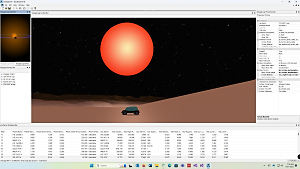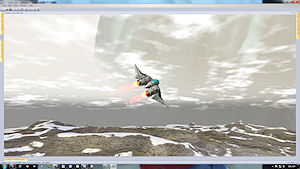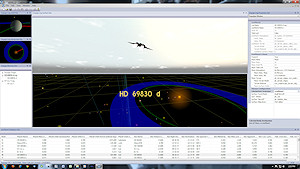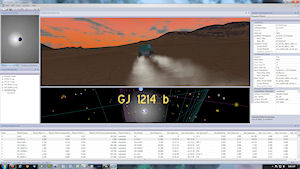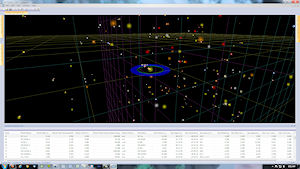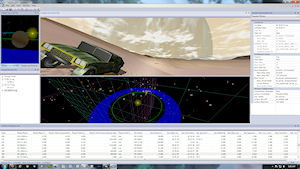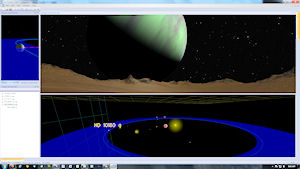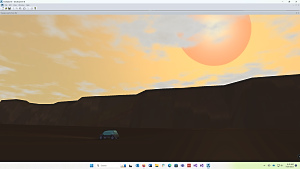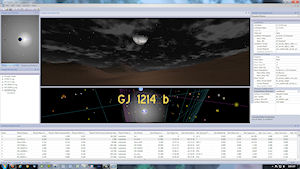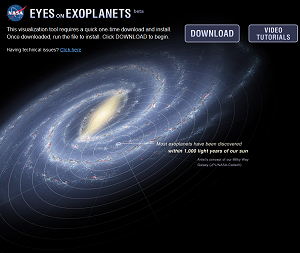exoExplorer
exoExplorer is a free Windows application, created by Tom Morris at PlanetaryBiology.com, to help astronomers, astrobiologists and astronomy enthusiasts visualize exoplanet environments.
Click image for larger view.
Visualizing hundreds of exoplanet environments with nothing more than a large table of data is laborious, unsatisfying and uninspiring. By providing several 3-D screens, exoExplorer lets users immerse themselves in the exoplanet’s simulated environment and see what it might be like to be on this planet or a moon orbiting nearby. exoExplorer lets you walk around, look around, drive around and fly around these mysterious new worlds.
As nearly all known exoplanets probably are large gas planets, and as such, have no well-defined atmosphere-rock interface, there is nowhere to stand. Users may fly around in the atmosphere of gaseous exoplanets, but for walking and driving, users are given the option of experiencing the space from the vantage point of a hypothetical moon in orbit around the exoplanet.
exoExplorer lets users adjust many environmental settings. Users may choose between atmospheres of different densities and chemical composition, terrains of different shapes and textures, moon present or not, moon tidally locked or not, and different types of surface vehicles.
Users may create a list of destinations (voyage legs) in a voyage itinerary and custom configure each voyage leg by adjusting the environmental settings mentioned above. Users may save and load voyages as exoExplorer documents. exoExplorer includes full data undo-redo.
exoExplorer uses the latest Microsoft MFC user interface with highly flexible and configurable windows. In addition, exoExplorer takes full advantage of the Ogre 3D graphics engine for visual scenes, Caelum for dynamic skies, Newton Game Dynamics for physics and collision detection, and Object-oriented Input System (OIS) for user input.
- Status: occasional development...
- Current version: Beta 0.9.3.1 for Windows 10 / 11 (May, 2023).
- Mission: to enable rapid visualization of and interaction with exoplanet environments.
- User Interface: Visual Studio style working interface.
- Data Source: exoExplorer will retrieve exoplanet data from planetarybiology.com and create exoplanet environments accordingly.
- Perspectives: exoExplorer presents four different animated viewing perspectives: 1) galactic 3D view; 2) star system orthographic view; 3) orbital 3D view; and 4) planetary (or imaginary lunar) surface 3D view.
- Navigation: Travel is performed with user-selected combinations of large and small craft, and large and small wheeled vehicles.
- Navigation Control: DirectInput -- mouse, keyboard, game controller.
- Programming Language: C++. Program development being performed with Microsoft Visual Studio 2015, 2019, and 2022.
- Supported Platform: Microsoft Windows 7 / 8.1 / 10 / 11.
- Libraries: Ogre3d, Newton Game Dynamics (OgreNewt), Object-oriented Input System (OIS), Caelum, OpenAL.
This is a BETA release of exoExplorer
A "BETA release" is a phase in the software development cycle where the software is released for public testing. Prior to this BETA release, exoExplorer had been tested internally and was found to be stable on the following computers:
- AMD Phenom II X4 940 3.0 GHz Quad core with 4 GB RAM, and nVidia GeForce 9600 GTX+ w/512 MB of video RAM.
- AMD Athlon 5200+ 2.7 GHz 64X2 Dual Core with 2 GB RAM, and nVidia GeForce 8600 GT w/ 512 MB of video RAM.
- Intel Celeron 2 GHz with 512 MB of RAM, and nVidia GeForce FX5200 w/ 128 MB of video RAM.
- AMD Athlon 2400+ 2.0 GHz with 1.5 GB of RAM, and an nVidia GeForce FX5500 w/ 128 MB of video RAM.
If your system is much different from this limited test bank, exoExplorer might not work on your machine.
Minimum System Requirements:
exoExplorer is a resource-demanding, graphics-intensive application that renders dynamic 3D scenes in four windows simultaneously. It runs best on gamer's platforms.
To achieve the most convincing realism, exoExplorer is designed to exploit the latest real time 3D rendering software, physics software, and recent generation graphics card hardware including vertex buffers, abundant and fast texture memory, simultaneous rendering in multiple windows, and shader programs run on the GPU.
Absolute minimum system requirements are listed below:
- Windows 7 / 8.1 / 10 / 11
- Microsoft DirectX 9.0
- Minimum CPU: Intel Celeron 2.0 GHz, or AMD Athlon 2400+ 2.0 GHZ
- System RAM: 1 GB (the more, the better)
-
Graphics card with vertex and fragment processing capability.
- Minimum: nVidia GeForce FX5200 w/128 MB video RAM (or equivalent ATI Radeon 9000; vertex and fragment capable)
- Go to this link for a list of nVidia / ATI Radeon graphics cards equivalents.
Recommended:
- High performance heatsink for your CPU. Rendering exoExplorer's multiple 3D views may push your CPU to run at a sustained 100%.
- Internet connectivity for receiving frequent database updates from planetarybiology.com .
- Joystick or equivalent game controller for access to"aircraft".
- Mouse with scroll wheel.
Reviewed by MakeUseOf
exoExplorer binaries and source code hosted by sourceforge.net

Download the exoExplorer installer at SourceForge.
exoExplorer Interface
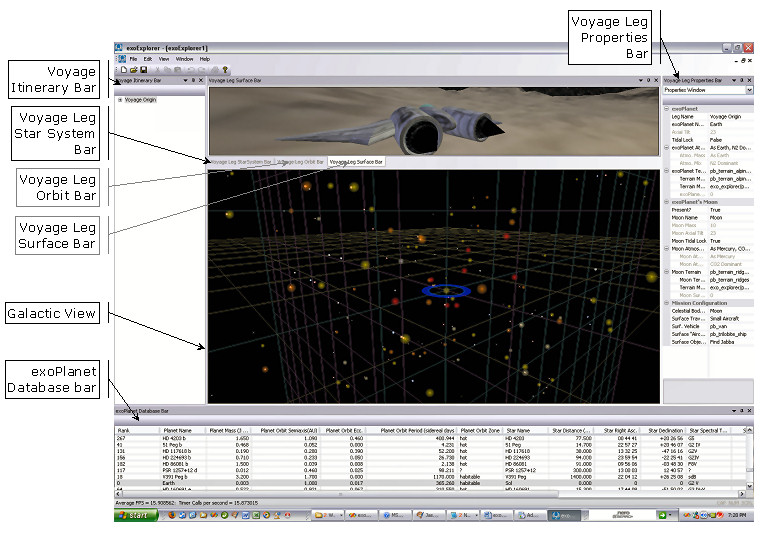
Keyboard Controls for 3D views
W = forward
S = back
A = left
D = right
F1 = first-person view in Voyage Leg Surface view.
F2 = chase view in Voyage Leg Surface view.
R = restart wheeled vehicle (use this in Voyage Leg Surface view when
car flips over)
E = get out of / get into wheeled vehicle / “air”craft in Voyage Leg
Surface view
H = toggle headlights in Voyage Leg Surface view
Mouse controls in 3D views
Left click on the exoplanet of your choice in the Galactic View
(Main view). This will display the planet’s name, orbital path, and
host star’s habitable zone. Also the planet’s database listing will be
highlighted and scroll into view.
Left click and move mouse to rotate camera up/down/left/right -- In
Galactic View and Voyage Leg Surface View.
Mouse scroll wheel to move the camera forwards/backwards – in
Galactic View, Voyage Leg Star System View and Voyage Leg
Orbital View.
Game Controller/Joystick controls in 3D views
Button 1 = forward
Button 2 = back
POV = slide up/down/left/right – in Galactic View and Voyage
Leg Surface View
X/Y axes to rotate up/down/left/right (pitch/yaw)
Z rotation to roll left/right
Adding exoplanets to Voyage Leg Itinerary Bar
Add exoplanets one-at-a-time by the following techniques:
Select the planet in the Database bar
Drag and drop onto the Voyage Leg Itinerary Bar
Or right click on the planet’s database listing and select the
command from the resulting context menu.
Activating an exoplanet to display in Voyage Leg 3D views
3D views reflect the currently active voyage leg.
To activate an exoplanet, double-click on the planet’s listing in the
Voyage Leg Itinerary Bar, or right-click on this listing and choose
the command from the resulting context menu.
Voyage Leg Properties
The Voyage leg Properties Bar displays the active voyage leg’s
current settings. You may modify many of these settings to create a
variety of orbital circumstances and environmental conditions.
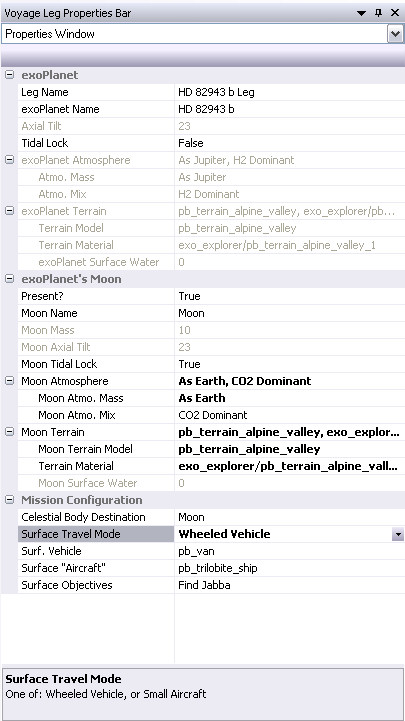
As a voyage leg is activated, the Properties Bar updates to reflect the active voyage's settings.
Making most modifications is pretty self-explanitory, but some are not. Here are some simple instructions.
Some properties are disabled. This may be because of the particular exoplanet's circumstances, or because the feature has not been implemented yet. Here are some examples...
When the exoplanet is a gas giant, exoExplorer makes no terrain for the exoplanet and disables the exoplanet's terrain properties.
The "moon" option for all exoplanets represents an imaginary body purely for the purpose of visualizing possible circumstances around the exoplanet. No actual exoplanet satellites have been observed or proposed.
Axial tilt for all worlds is fixed at 23 degrees. Code to enable this feature has not yet been written.
You may choose to be "on the exoplanet" or "on the exoplanet's moon" by selecting your destination from the "Celestial Body Destination" drop down box. When changing locations, the Voyage Leg Surface view updates to reflect the conditions and properties for the chosen celestial body.
Terrain and atmosphere modification. Note that terrains and atmospheres for exoplanet and moon are handled independently. You may modify the terrain material (texture) by choosing among available choices in the "Terrain Material" dropdown box.
You may choose a different terrain model (mesh) by selecting among choices available in the "Terrain Model" dropdown box. Once a new model is chosen there will be a delay as the mesh must be loaded into the renderer and a new physics model must be constructed for it. Initially, the new terrain model will possess the material from the previous terrain model. New material choices, intended for the new model, become available in the Terrain Material dropdown box. Choose a new terrain material from this new list.
You may modify the appearance of the atmosphere in several ways. The "Atmos Mass" property gives you three options. "As Mercury" means no atmosphere. "As Earth" means a substantial but transparent atmosphere. "As Jupiter" means an extremely thick and opaque atmosphere.
If your celestial body has an atmosphere, you may alter its appearance by choosing different mixes with the Atmos. Mix" property. Three choices are available: H2 dominant, CO2 dominant, N2 dominant.
Tidal locking is a fun feature to experiment with. Tidal locking for the moon means that as the moon orbits the exoplanet, the same side of the moon always faces the exoplanet -- like the Moon and Earth. Tidal locking for the exoplanet means that as the exoplanet orbits its star, the same side of the planet always faces the star -- like Mercury and our sun. Try different combinations of tidal locking for the exoplanet and the moon.
You may choose between different travel modes with the "Surface Travel Mode" dropdown box. Two modes are available, wheeled vehicle and small aircraft. Two choices for surface vehicle, and only a single type of small aircraft are currently available.
Rearranging exoExplorer Workspace Layout
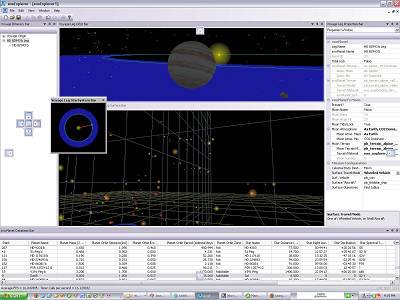
You may rearrange exoExplorer's layout by clicking the title bars of the interface elements and dragging them to your desired positions. While dragging, layout hints appear. Drag your mouse over the layout hint image of your choice and release. You may resize all bars by clicking on the bar's edge and dragging. The Galactic View is the document's main view and behaves as a traditional document view.
Aftre exiting exoExplorer, your new layout will be preserved and restored the next time you load exoExplorer.
Connecting to the Internet for Database Updates
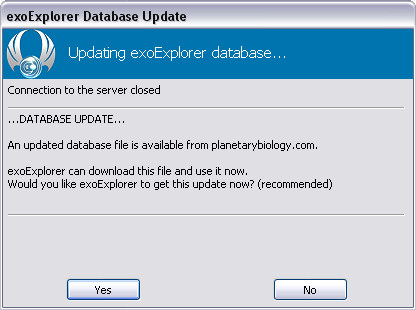
At startup, exoExplorer attempts to open an internet connection for the purpose of seeking the latest exoplanet database file from planetarybiology.com. exoExplorer opens a dialog box so that you can observe the progress of this operation. If exoExplorer finds a more recent database file on planetarybiology.com, it will notify you of this fact and request your approval to download this file. If approved, exoExplorer will download the new database file to the application’s folder, then it closes the internet connection. exoExplorer performs no other operations while connected to the internet.
Speeding up Sky Motion
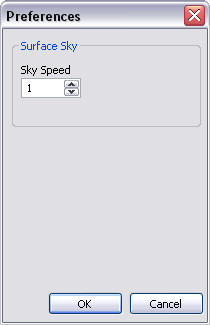
You may change the speed of the sky simulation in the Voyage leg Surface View.
Go to Edit->Preferences. The Preference dialog box pops up. Use the Sky Speed control. Observe the results in the Voyage leg Surface View.
Note: Cloud speed is not affected.

